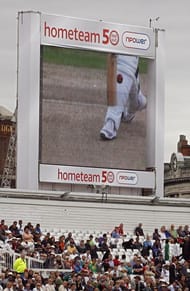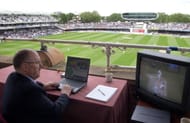Umpires have been a part of the game of cricket ever since it started. Professional or amateur, domestic or international, two umpires have always been deemed necessary to ensure fair play with respect to the number of runs scored or wickets taken.
Till the 70s, the on-field umpire’s calls used to be the final verdict. In any case, there wasn’t too much evidence to go against it as cricket wasn’t extremely popular as a televised sport in the countries where television already existed and the government broadcasters did not find it necessary to invest in their programming of the game.
All that changed with World Series Cricket. Kerry Packer had the foresight to see that the game had a high EQ (entertainment quotient), and he heavily invested in the game to make it more appealing to women and children, who otherwise were not overtly impressed with the vagaries of the sport. Channel Nine was one of the first broadcasters who used slow-motion cameras for replays of interesting moments of the game.
By the late 80s, cricket (especially limited overs internationals) was a big thing and more so in the subcontinent thanks to India’s World Cup victory in ’83 and the Reliance World Cup of 1987. Sharjah was now an immensely popular destination for cricket and a source of big money thanks to the large number of Indian and Pakistani expatriates who had settled there. Cricket advertising was on a blitzkrieg and a company like Gillette was more synonymous with cricket than razors.
The unbelievable commercialization of the game meant that each ball bowled, and each run scored, was associated with big money. The umpire’s job was under immense scrutiny as even borderline decisions would now come in for extreme criticism. Clearly, the level of competence required was beyond the limits of a human being.
It was then that the hunter became the saviour. In 1984, an accountant-turned-cricket journalist Mahinda Wijesinghe submitted a proposal to the ICC where he argued that the very slow motion cameras, which had exposed the on-field umpires throughout the 80s, could actually be used to help them take better decisions.
The proposal was rejected on the grounds that this would add to the overall playing time, reduction of which was one of the main reasons why a limited overs format was introduced.
Three months later, in the Ashes Test at Sydney, John Dyson was run out by “a mile” (18 inches) by Bob Willis off his own bowling. Except the fact that he was given not out by the square leg umpire Mel Johnson. Dyson continued to bat for five hours, making a crucial 79 which helped Australia regain the Ashes. The tipping points in Wijesinghe’s favour had started to accumulate.
The ICC relented but took a long time to do so. On 12 November 1992, Karl Liebenberg and Cyril Mitchley walked into a small cubby hole of a room rigged up with a TV monitor and a lot of circuitry at the Kingsmead stadium in Durban. The occasion was the first Test match between India and South Africa.
It took them a day, but Liebenberg claimed his first victim the next day when he “ran Sachin Tendulkar out”. Ever since then, the third umpire has been a pivotal figure in the game and his presence, though understated, is always expected to be obvious.
The acceptance of technology in cricket had further implications. Around the mid-90s, an English computer scientist Allan Plaskett started working on a technology which could graphically analyse sound and video.
This technology would enable the listener of the sound to “see” the sound as a shape on a waveform. The objective was to determine edges or snicks in cricket – a woody sound would be sharper than that of a ball hitting the pad or the bat hitting the pads, which would have a fatter waveform. The ‘Snickometer’ was formally introduced by Channel 4 in the UK in 1999 and Channel Nine in Australia soon after that.
Plaskett’s contemporary, Dr. Paul Hawkins meanwhile was developing something of his own at Roke Manor Research Limited, a subsidiary of Siemens.
He set up a number of high-speed cameras in conjunction with a ball tracker at different locations and angles around a “playing area”. The cameras and the ball tracker sent inputs to a system which rapidly processed the video feed and built up a record of the path along which the ball has travelled.
Using the principles of triangulation, the system would “predict” the future path of the ball had it not interacted with any of the playing area features.
The Hawkeye system was built for a variety of sports, but it found its primary use in cricket (and also tennis, to verify line calls) for checking the trajectory of balls in flight and later for checking LBW decisions.
In 2001, Channel 4 utilised the services of this technology for the first time in a Test match between Pakistan and England at Lord’s. The following year, the Hawkeye came in for a bout of serious criticism during the India-England Test series. Harbhajan Singh bowled Andy Caddick with a ball that just clipped the bails, whereas Hawkeye showed the ball’s trajectory would miss the stumps by a little margin.
In the early 2000s, Channel Nine was not concerned about the efficacy of the Snickometer. At the same time they happened to chance upon a technology founded by French scientist Nicholas Bion, which was being developed further by many Parisian companies.
The technology involved the use of infra-red cameras to sense and measure heat from friction generated by collision which would then generate a series of negative frames on a computer using a subtraction technique to locate the point of collision.
The ‘Hot Spot’ technique was used by the military to track tanks and jet fighters but apparently, Channel Nine thought that they could put it to better use in cricket, and hence they bought it out. They used the technology for the first time in the Gabba Test of the 2006-07 Ashes.
The 2008 season saw the launch of the inaugural IPL. It was an immediate success, and now more money was expected to be riding on the game of cricket. The ICC was also looking to expand the game in more countries and, for that, they needed a system to convince the onlookers that the game was as fair as it possibly could be.
In the winter of that year, they trialled the Hawkeye as a part of their future Decision Review programme. If a team disagreed with an LBW decision, they could ask the on-field umpire to raise the question to the third umpire who would be able to look at what the ball did up to the point it actually hit the batsman, but not beyond that.
Six months later, deeming that the Snicko was not accurate enough, they validated the use of Hot Spot for player trials during the Test series between Australia and South Africa in South Africa.
On the 24th of September 2009, the ICC rolled out the Umpire Decision Review System (UDRS or DRS) during the Dunedin Test match between New Zealand and Pakistan. The UDRS included an allowance to make two unsuccessful review requests per innings during a Test match (and one during a One-Day International) for each team.
The ICC had initially planned to make it mandatory for all international matches but was coerced by the BCCI to leave it to the teams involved to mutually agree on DRS. However, it is mandatory for all ICC events.
The response has generally been positive, but a few observers have felt it was more of a gimmick and undermined the authority of the on-field umpires. India is a vocal critic of the system, labelling it as an adulteration of human decision and technology instead of being completely one of the two.
The DRS is still very much a work in progress as the recent amendments on the LBW protocols last year show.
While the Hot Spot is assumed to be 90-95% accurate, doubts remain over the Hawkeye as well as the number of review requests which should be given to a team.
Nevertheless, the DRS is a significant milestone in the history of the game. With the use of a third umpire, the ICC accepted the use of technology for the game, and with the DRS they have embraced it more so. One just hopes it does not reach a point where they become overly dependent on it.
Read more about such events which altered the way cricket was played over the years – The moments that changed cricket forever.
Follow IPL Auction 2025 Live Updates, News & Biddings at Sportskeeda. Get the fastest updates on Mega-Auction and cricket news



